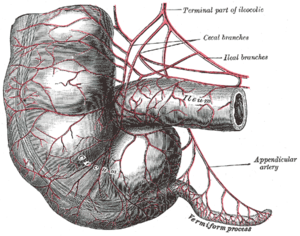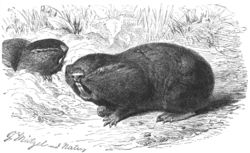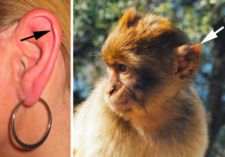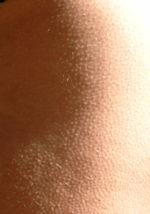Vestigial structure
2007 Schools Wikipedia Selection. Related subjects: General Biology
Vestigial structures are anatomical structures of organisms in a species which are considered to have lost much or all of their original function through evolution. These structures are typically in a degenerate, atrophied, or rudimentary condition or form. Vestigial structures are often referred to as vestigial organs, though not all of them are actually organs.
Although the structures most commonly referred to as "vestigial" tend to be largely or entirely functionless, a vestigial structure need not necessarily be without use or function for the organism. Vestigial structures have lost their original main purpose, but they may retain lesser functionalities, or develop entirely new ones. Thus, a "vestigial wing" need only be useless for flight to be vestigial; it may still serve some other purpose than that of a wing.
History
Vestigial structures have been noticed since ancient times, and the reason for their existence has long been speculated upon. In the 4th century BC, Aristotle was one of the earliest writers to comment, in his History of Animals, on the vestigial eyes of moles, calling them "stunted in development". However, only in recent centuries have anatomical vestiges become a subject of serious study. In 1798, Étienne Geoffroy Saint-Hilaire noted on vestigial structures:
| “ | Whereas useless in this circumstance, these rudiments... have not been eliminated, because Nature never works by rapid jumps, and She always leaves vestiges of an organ, even though it is completely superfluous, if that organ plays an important role in the other species of the same family. | „ |
His colleague, Jean-Baptiste Lamarck, named a number of vestigial structures in his 1809 book Philosophie Zoologique. Lamarck noted " Olivier's Spalax, which lives underground like the mole, and is apparently exposed to daylight even less than the mole, has altogether lost the use of sight: so that it shows nothing more than vestiges of this organ."
Charles Darwin was very familiar with the concept of vestigial structures, though the term for them did not yet exist. He listed a number of them in The Descent of Man, including the muscles of the ear, wisdom teeth, the appendix, the tail bone, body hair, and the semilunar fold in the corner of the eye. Darwin also noted, in The Origin of Species, that a vestigial structure could be useless for its primary function, but still retain secondary anatomical roles: "An organ serving for two purposes, may become rudimentary or utterly aborted for one, even the more important purpose, and remain perfectly efficient for the other.... [A]n organ may become rudimentary for its proper purpose, and be used for a distinct object."
In 1893, Robert Wiedersheim published a list of 86 human organs that had, in his words, "lost their original physiological significance". Theorizing that they were vestiges of evolution, he called them "vestigial". Since his time, the function of some of these structures has been discovered, while other anatomical vestiges have been unearthed, making the list primarily of interest as a record of the knowledge of human anatomy at the time. Later versions of Wiedersheim's list were expanded to as many as 180 human "vestigial organs". This is why the zoologist Newman stated in the Scopes Monkey Trial that "There are, according to Wiedersheim, no less than 180 vestigial structures in the human body, sufficient to make of a man a veritable walking museum of antiquities."
Evidence of evolution
Vestigial structures are often homologous to structures that are functioning normally in other species. Therefore, vestigial structures can be considered evidence for evolution, the process by which beneficial heritable traits arise in population over an extended period of time. The existence of vestigial organs can be attributed to changes in the environment and behaviour patterns of the organism in question. As the function of the structure is no longer beneficial for survival, the likelihood that future offspring will inherit the "normal" form of the structure decreases.
The vestigial versions of the structure can be compared to the original version of the structure in other species in order to determine the homology of a vestigial structure. Homologous structures indicate common ancestry with those organisms that have a functional version of the structure.
Humans
Although the list of human vestigial structures is still more or less the same, the relative usefulness of certain structures on the list is a subject of debate. The following are some of the structures often included in this list:
The vermiform appendix is a vestige of the cecum, an organ that was used to digest cellulose by humans' herbivorous ancestors. Analogous organs in other animals similar to humans continue to perform that function, whereas other meat-eating animals may have similarly diminished appendices. The modern functionality of the appendix is still controversial in the field of human physiology, although most scientists and physicians believe that it has little or no function.
The coccyx, or tailbone, is the remnant of a lost tail. All mammals have a tail at one point in their development; in humans, it is present for a short time during embryonic development. The tailbone, located at the end of the spine, has lost its original function in assisting balance and mobility, though it still serves some secondary functions, such as being an attachment point for muscles, which explains why it has not degraded further. In rare cases it can persist after birth and must be surgically removed.
The plica semilunaris is small fold of tissue on the inside corner of the eye. It is the vestigial remnant of the nictitating membrane (the "third eyelid") which is present in other animals.
Wisdom teeth are vestigial third molars that humans' ancestors used to help in grinding down plant tissue. It has been proven that the skulls of human ancestors had larger jaws with more teeth, which were probably used to help chew down foliage to compensate for a lack of ability to efficiently digest the cellulose that makes up a plant cell wall. As humankind's diet changed, a smaller jaw was selected for by evolution, but the third molars, or "wisdom teeth", still commonly grow in.
Humans also bear some vestigial behaviors and reflexes. For example, the formation of goose bumps in humans under stress is a vestigial reflex; its purpose in humans' evolutionary ancestors was to raise hair to make the animal appear bigger and scare off predators. Raising the hair is also used to trap an extra layer of air, to keep the animal warm. This reflex formation of goosebumps when cold is not vestigial in humans, but the reflex to form them under stress is.
The ears of a Macaque monkey and most other monkeys, have far more developed muscles than those of humans and therefore have the capability to move their ears to better hear potential threats. This inability is compensated mainly by the ability of humans to turn their heads on a horizontal plane, an ability which is not common to most apes. Therefore, a function once provided by one structure is now replaced by another.
There are also vestigial molecular structures in humans, which are no longer in use but may indicate common ancestry with other species. One example of this is L-gulono-gamma-lactone oxidase, a gene, found functional in most other mammals, which produces a Vitamin C-catalyzing enzyme. In humans, an earlier mutation may have caused it to become disabled (unable to produce the enzyme), and it now remains in the human genome only as a vestigial genetic sequence.
In other organisms
In whales and other cetaceans, one can find small vestigial leg bones deeply buried within the back of the body. These are remnants of their land-living ancestors' legs. Many whales also have undeveloped, unused, pelvis bones in the anterior part of their torsos.
Penguins and Dodo birds (now extinct) have hollow bones, a feature usually reserved for flying birds. (The weight reduction is crucial to staying in the air. Since both birds don't fly, having hollow bones is unneeded, and therefore vestigial.) The wings of ostriches, emus, and other flightless birds are vestigial; they are remnants of their flying ancestors' wings.
The eyes of certain cavefish and salamanders are vestigial, as they no longer allow the organism to see, and are remnants of their ancestors' functional eyes.
Crabs have small tails tucked between their rear legs that are probably vestigial, as they are no longer in use. The working version of these tails can be found in their close crustacean relative, the lobster.
Vestigial structures are not only found in animals; plants also are known to have vestigial parts. Dandelions and other asexually reproducing plants produce unneeded flower petals. These petals were once used to attract pollinating insects, but are now no longer needed.
Grass and other non-flowering angiosperms often have small, undeveloped structures which strongly resemble those of flowering plants.
The eyes of a flounder start off on either side of the flounder's head. Shortly after birth, one of the eyes moves around to the other side of the fish's head.
Fruit flies have been known to occasionally grow legs where their antennae should be. This suggests that the antennae and legs have a similar origin, or that during development appendages are signaled to develop into their respective forms. In this case, it is possible the signal did not occur correctly.
Certains species of moths (for example the Gypsy moth) have females that although flightless, still carry small wings. These wings have no use, and are vestigial to the versions in species whose females can fly.
Controversy
Because vestigial organs are used as supporting evidence for evolution, some creationists oppose the validity of the idea. They question whether these organs are actually useless, since they believe that God gave each organism its organs for a specific reason and use.
Those who question the existence of vestigial organs usually claim a different definition for vestigial, giving a strict interpretation that an organ must be utterly useless to qualify. This is a definition often used in dictionaries and children's encyclopedias. Biology textbooks and scientific encyclopedias usually describe an organ as vestigial if it does not serve the same function in the modern animal as the cognate organ served in an ancestor, even if the modern organ serves a completely different use ( preadaptation).
Those who consider the true meaning of vestigial to be "completely without use" tend to claim that the meaning has been changed over time as structures thought to be vestigial were found to have other uses. However, documentation indicates that from the theory's beginnings in the 19th century, vestigial structures have invariably been understood to "sometimes retain their potentiality", becoming either "wholly or in part functionless". It was thought that "not infrequently the degenerating organ can be turned to account in some other way".
An example of the dispute is the gas bladder of many fish, which is thought to be a vestigial lung, "left over" from the occasionally-air-gasping common ancestor of ray-finned fish and land vertebrates.




